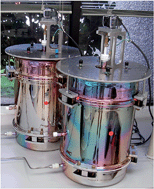Indoor air pollutants require careful and accurate monitoring in order to ensure people are not exposed to levels that could cause adverse health effects. This study, commissioned by the U.S. Department of Defense, demonstrates the usefulness of diffusive passive air samplers for this purpose.
People can potentially be exposed to dangerous levels of air pollutants indoors, either directly from indoor sources or from polluted air transported from outside. The WHO has acknowledged the threat of poor indoor air quality, identifying a number of specific pollutants of concern and providing guidance on health effects and recommended guideline exposure limits associated with these contaminants. One class of pollutants causing concern are volatile organic compounds (VOCs). The USEPA warn that VOCs have been linked with a number of adverse health effects including damage to the kidney, liver and central nervous system, as well as eye, nose and skin irritation, headaches and nausea.
Domestic combustion sources, such as heating and cooking, are known to be important sources of VOCs; however, an emerging source of interest is the intrusion of vapour from contaminated soil or groundwater into a building. Careful monitoring of VOCs is clearly needed to carry out appropriate risk assessment and identify the relative contribution of this intrusive source on total VOC concentration in the indoor environment. Conventional air sampling methods typically do not allow for monitoring for more than a 24 hour period. However, due to the temporal variability of some VOCs, longer sampling duration is needed to better represent the long-term average concentrations of VOCs.
Passive diffusive samplers are therefore well-suited to this application as they have the ability to detect relatively low concentrations of contaminants over relatively long sampling duration. Passive air samplers commonly use a sorbent material to trap VOCs, which reach the sampler via diffusive transfer from the surrounding atmosphere. A time-weighted average concentration can be calculated subsequently in the lab. Passive sampling has been used for indoor air quality monitoring in occupational settings for decades, but the application to monitoring subsurface vapour intrusion to indoor air requires further work to assess their capabilities and limitations for lower concentrations and longer exposure durations.
This article by Todd McAlary and co-workers, combining work of research laboratories in Canada, the USA, UK and Italy, describes laboratory testing of passive diffusive samplers for assessing indoor air concentrations of VOCs in order to demonstrate and validate their potential usefulness.
Four different passive samplers were tested, utilising different types of sorbent, under a wide range of controlled laboratory conditions (temperature, humidity, VOC concentration and sampling duration) with review from leading experts on each sampler type. 10 different VOCs were measured including aliphatic compounds such as alkenes and alkanes as well as aromatic compounds such as benzene and naphthalene, in order to assess compounds that cover a range of physiochemical properties and some compounds that pose a challenge to sampling.
The results demonstrate that passive samplers can potentially provide data that is more representative of long-term average indoor air concentrations than conventional methods that are limited to shorter sample durations. The results show the passive samplers proved data that meets a set of success criteria for most of the compounds tests, although some compounds were identified as being more problematic. The study provides a unique and valuable new body of data on indoor air quality monitoring. However, the authors also caution that passive sampling programs will need to be supplemented by quality assurance measures. For example, outdoor air samples should be taken simultaneously with indoor sampling to help ascertain the relative contributions of different pollution sources.
To access the full article, download a copy for free* by clicking the link below:
Passive sampling for volatile organic compounds in indoor air-controlled laboratory comparison of four sampler types
Todd McAlary, Hester Groenevelt, Stephen Disher, Jason Arnold, Suresh Seethapathy, Paolo Sacco, Derrick Crump, Brian Schumacher, Heidi Hayes, Paul Johnson and Tadeusz Góreckic
Environ. Sci.: Processes Impacts, 2015, Advance Article
DOI: 10.1039/c4em00560k
—————-
Ian Keyte is a Doctoral Researcher at the University of Birmingham. His research focuses on the sources, behavior and fate of polycyclic aromatic hydrocarbons (PAHs) in the atmosphere.
—————-
* Access is free until 07/06/2015 through a registered RSC account.












